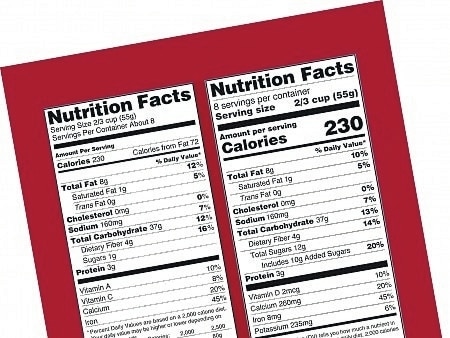
Question: I heard something on the news about the Nutrition Facts labels changing. What are the details?
Answer: The new Nutrition Facts information won’t be on food labels for a while, but you may like what you see when they do appear.
The U.S. Food and Drug Administration announced the updated design on May 20. Large manufacturers have until July 26, 2018, to start using the new label. Smaller companies will get an extra year. This is the first update to the Nutrition Facts label in 20 years.
One of the most sought-after changes will be the inclusion of “Added Sugars” on the label. Currently, the label just includes “sugars” as a category under carbohydrates, but it’s impossible to tell how much of that is naturally occurring, from fruit- or milk-based ingredients, for example, and how much is added during processing.
The 2015 Dietary Guidelines for Americans recommends that we limit added sugars to no more than 10 percent of our daily calorie intake. So, if you eat about 2,000 calories a day, you should consume no more than 200 calories, or 50 grams, of added sugars a day. The new labels will list the amount of added sugars in both grams and as a percent of a 2,000-calorie-a-day diet. This will not only help consumers interested in limiting their added sugar intake, it could encourage manufacturers to reduce the amount of added sugars they use in their products.
Other changes in the new label include:
Larger and bolder typeface for both calories and serving sizes. These two pieces of information are among the most important to help people make healthy food choices, but they don’t get much prominence on the current label.
Some foods will have “dual column” labels to indicate both “per serving” and “per package” calorie and nutrition information. These will be required on products that have multiple servings but could reasonably be consumed all in one sitting, such as a pint of ice cream or a 3-ounce bag of chips. The first column will provide nutrition information if you just consume one serving — 1 ounce of those chips in the 3-ounce bag, for example. The second column will provide the same information if you eat the entire package.
Labels will include information on vitamin D and potassium content. Some people are not getting enough of these nutrients, which puts them at higher risk for chronic disease. Labels will no longer be required to list vitamins A and C, because deficiencies in those vitamins are now rare. Calcium and iron will continue to be listed. A bonus: Instead of listing just a percentage, or the “percent Daily Value,” these nutrients will also have the actual amount listed in grams. Daily Values are helpful indicators of how much a food provides towards the daily recommended amount for a 2,000-calorie-a-day diet, but it also can be helpful for consumers to see what that equates to in actual grams.
For more details on the new Nutrition Facts labels, go to www.fda.gov.


